2008 DODGE RAM 3500 DIESEL low oil pressure
[x] Cancel search: low oil pressurePage 284 of 527
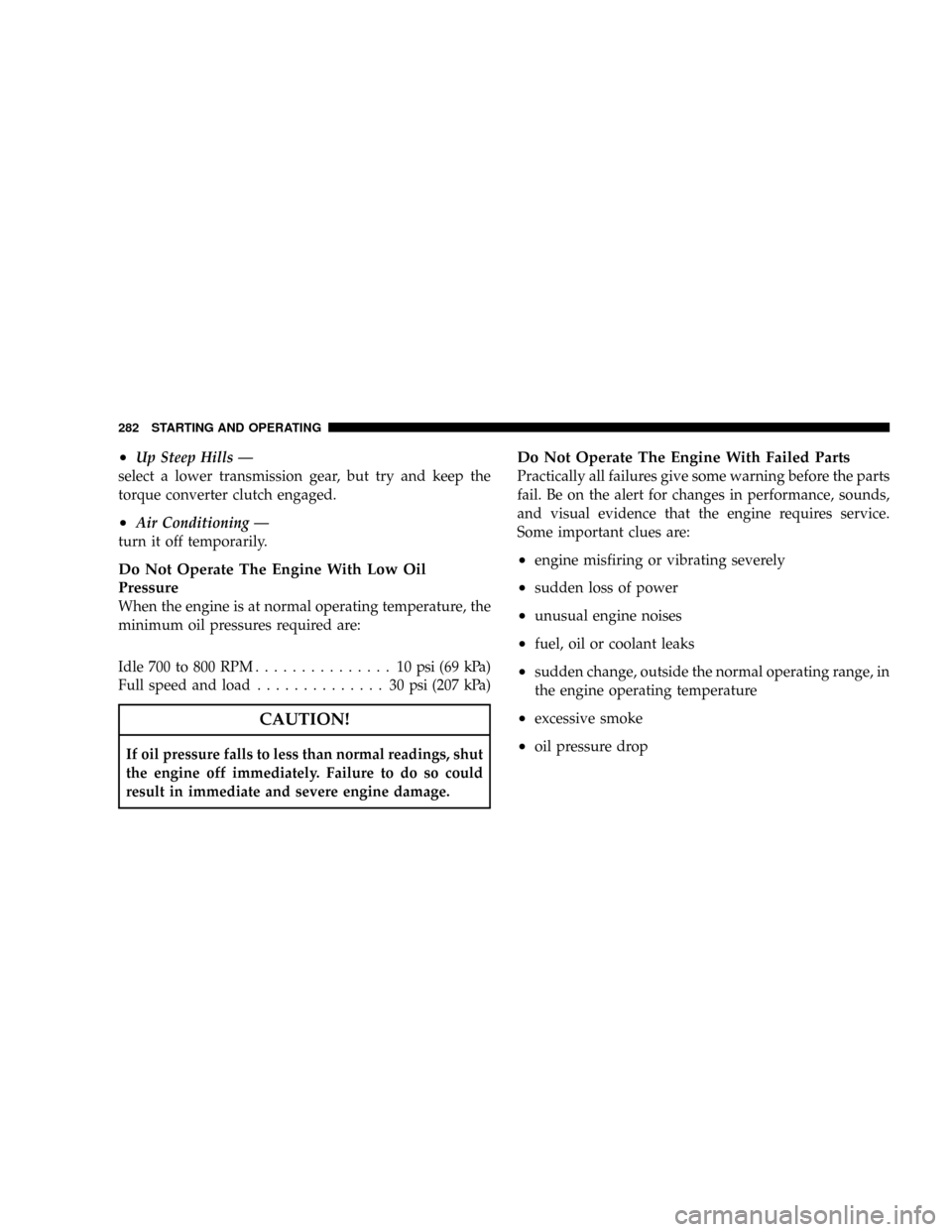
²Up Steep Hills Ð
select a lower transmission gear, but try and keep the
torque converter clutch engaged.
²Air Conditioning Ð
turn it off temporarily.
Do Not Operate The Engine With Low Oil
Pressure
When the engine is at normal operating temperature, the
minimum oil pressures required are:
Idle 700 to 800 RPM............... 10psi(69kPa)
Full speed and load.............. 30psi(207 kPa)
CAUTION!
If oil pressure falls to less than normal readings, shut
the engine off immediately. Failure to do so could
result in immediate and severe engine damage.
Do Not Operate The Engine With Failed Parts
Practically all failures give some warning before the parts
fail. Be on the alert for changes in performance, sounds,
and visual evidence that the engine requires service.
Some important clues are:
²engine misfiring or vibrating severely
²sudden loss of power
²unusual engine noises
²fuel, oil or coolant leaks
²sudden change, outside the normal operating range, in
the engine operating temperature
²excessive smoke
²oil pressure drop
282 STARTING AND OPERATING
Page 333 of 527
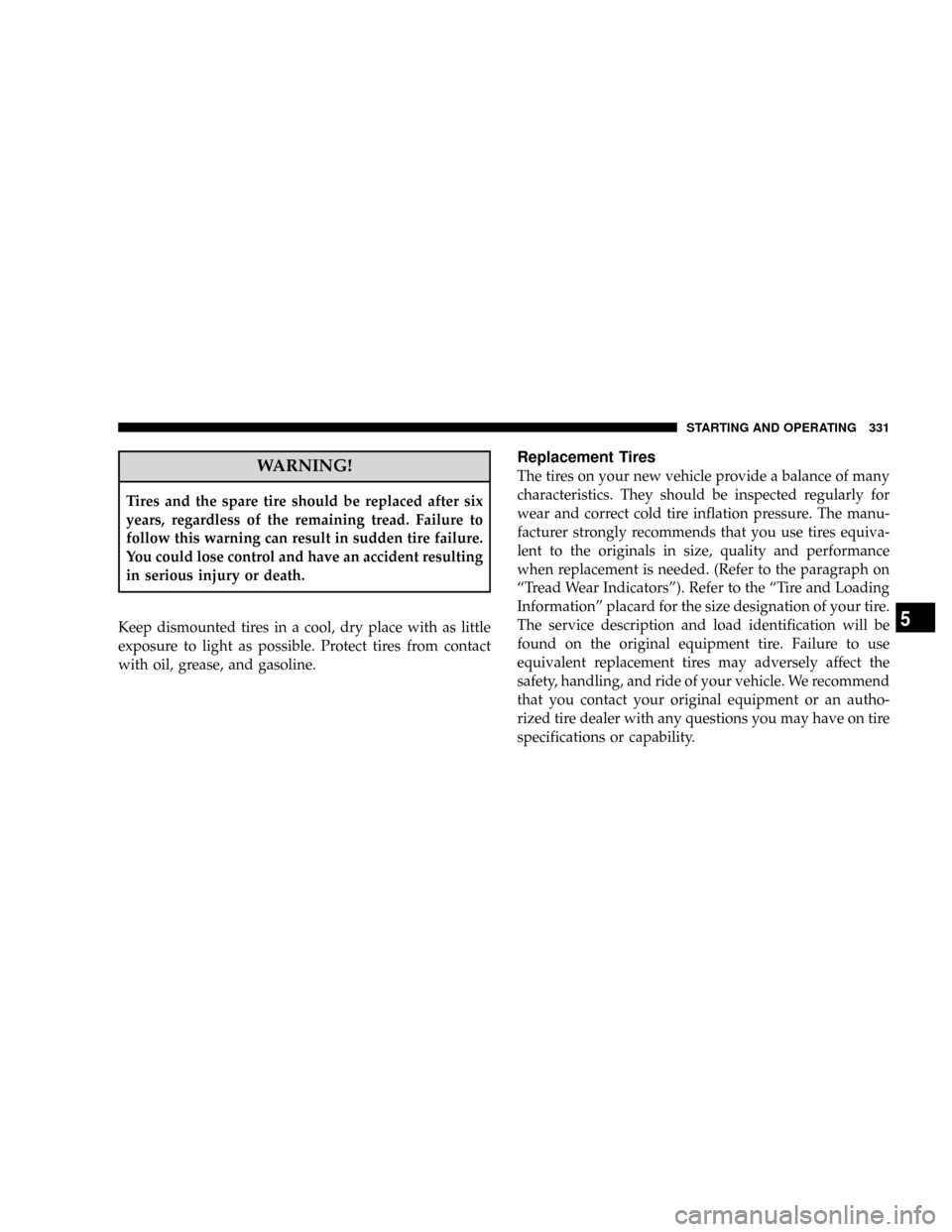
WARNING!
Tires and the spare tire should be replaced after six
years, regardless of the remaining tread. Failure to
follow this warning can result in sudden tire failure.
You could lose control and have an accident resulting
in serious injury or death.
Keep dismounted tires in a cool, dry place with as little
exposure to light as possible. Protect tires from contact
with oil, grease, and gasoline.
Replacement Tires
The tires on your new vehicle provide a balance of many
characteristics. They should be inspected regularly for
wear and correct cold tire inflation pressure. The manu-
facturer strongly recommends that you use tires equiva-
lent to the originals in size, quality and performance
when replacement is needed. (Refer to the paragraph on
ªTread Wear Indicatorsº). Refer to the ªTire and Loading
Informationº placard for the size designation of your tire.
The service description and load identification will be
found on the original equipment tire. Failure to use
equivalent replacement tires may adversely affect the
safety, handling, and ride of your vehicle. We recommend
that you contact your original equipment or an autho-
rized tire dealer with any questions you may have on tire
specifications or capability.
STARTING AND OPERATING 331
5
Page 349 of 527
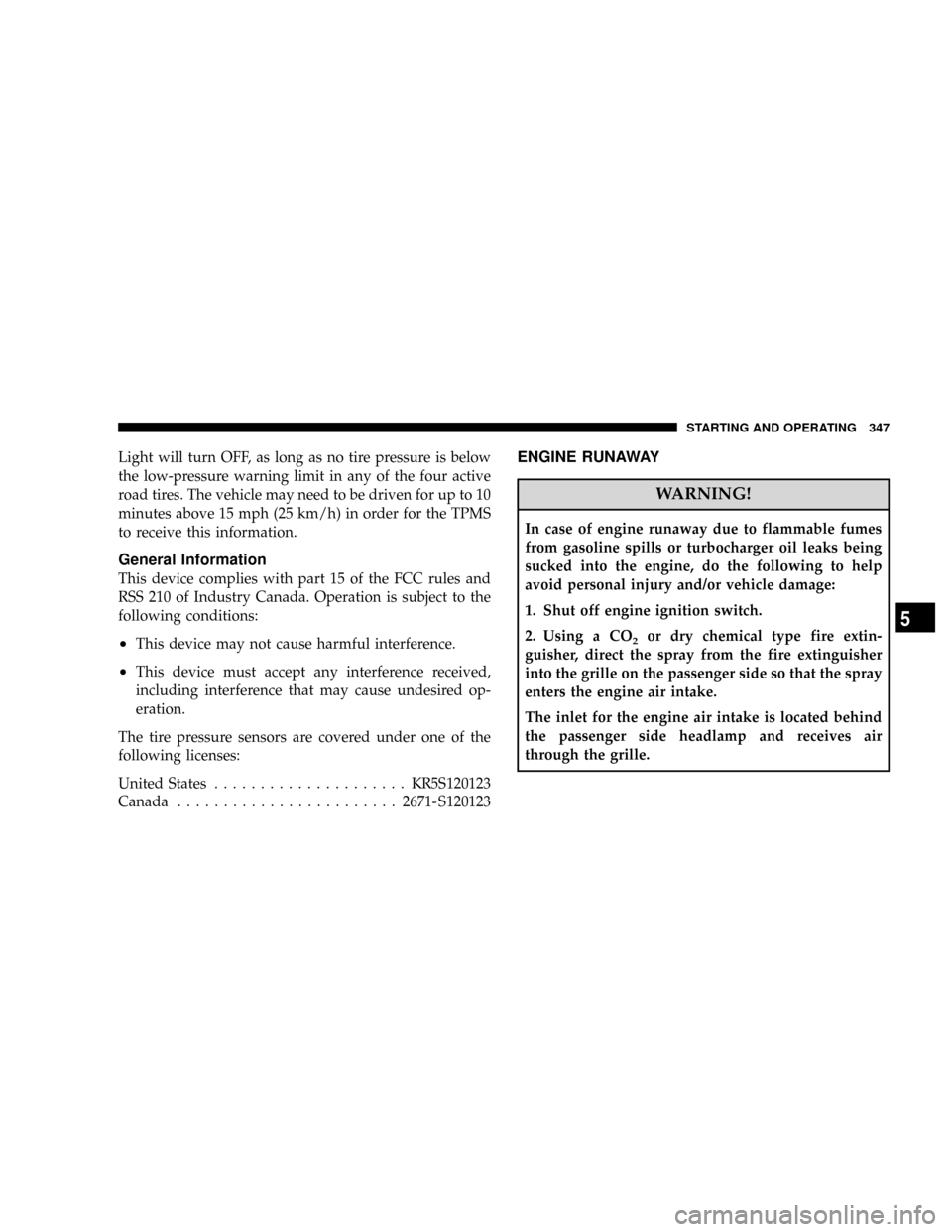
Light will turn OFF, as long as no tire pressure is below
the low-pressure warning limit in any of the four active
road tires. The vehicle may need to be driven for up to 10
minutes above 15 mph (25 km/h) in order for the TPMS
to receive this information.
General Information
This device complies with part 15 of the FCC rules and
RSS 210 of Industry Canada. Operation is subject to the
following conditions:
²This device may not cause harmful interference.
²This device must accept any interference received,
including interference that may cause undesired op-
eration.
The tire pressure sensors are covered under one of the
following licenses:
United States.....................KR5S120123
Canada........................2671-S120123
ENGINE RUNAWAY
WARNING!
In case of engine runaway due to flammable fumes
from gasoline spills or turbocharger oil leaks being
sucked into the engine, do the following to help
avoid personal injury and/or vehicle damage:
1. Shut off engine ignition switch.
2. Using a CO
2or dry chemical type fire extin-
guisher, direct the spray from the fire extinguisher
into the grille on the passenger side so that the spray
enters the engine air intake.
The inlet for the engine air intake is located behind
the passenger side headlamp and receives air
through the grille.
STARTING AND OPERATING 347
5
Page 394 of 527
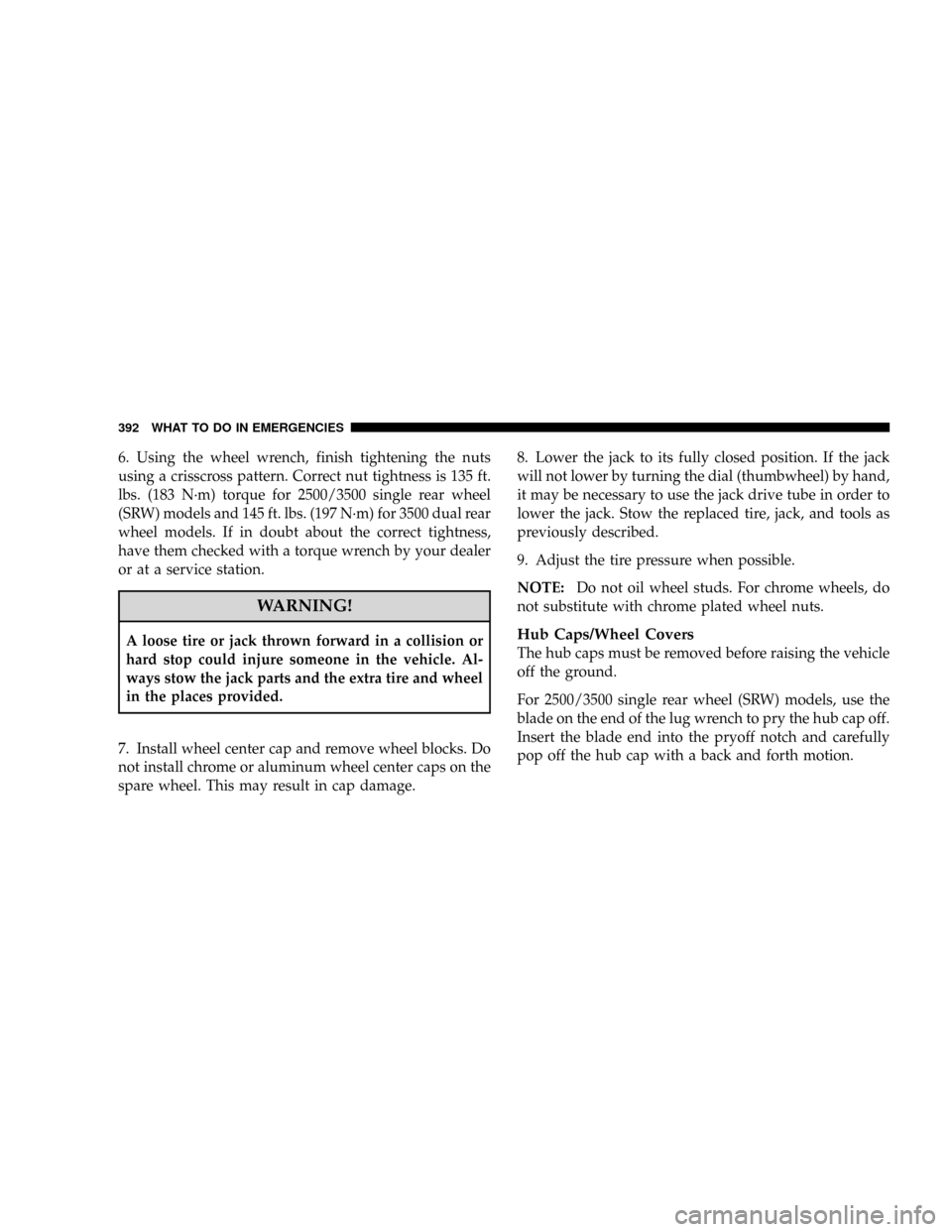
6. Using the wheel wrench, finish tightening the nuts
using a crisscross pattern. Correct nut tightness is 135 ft.
lbs. (183 N´m) torque for 2500/3500 single rear wheel
(SRW) models and 145 ft. lbs. (197 N´m) for 3500 dual rear
wheel models. If in doubt about the correct tightness,
have them checked with a torque wrench by your dealer
or at a service station.
WARNING!
A loose tire or jack thrown forward in a collision or
hard stop could injure someone in the vehicle. Al-
ways stow the jack parts and the extra tire and wheel
in the places provided.
7. Install wheel center cap and remove wheel blocks. Do
not install chrome or aluminum wheel center caps on the
spare wheel. This may result in cap damage.8. Lower the jack to its fully closed position. If the jack
will not lower by turning the dial (thumbwheel) by hand,
it may be necessary to use the jack drive tube in order to
lower the jack. Stow the replaced tire, jack, and tools as
previously described.
9. Adjust the tire pressure when possible.
NOTE:Do not oil wheel studs. For chrome wheels, do
not substitute with chrome plated wheel nuts.Hub Caps/Wheel Covers
The hub caps must be removed before raising the vehicle
off the ground.
For 2500/3500 single rear wheel (SRW) models, use the
blade on the end of the lug wrench to pry the hub cap off.
Insert the blade end into the pryoff notch and carefully
pop off the hub cap with a back and forth motion.
392 WHAT TO DO IN EMERGENCIES
Page 414 of 527
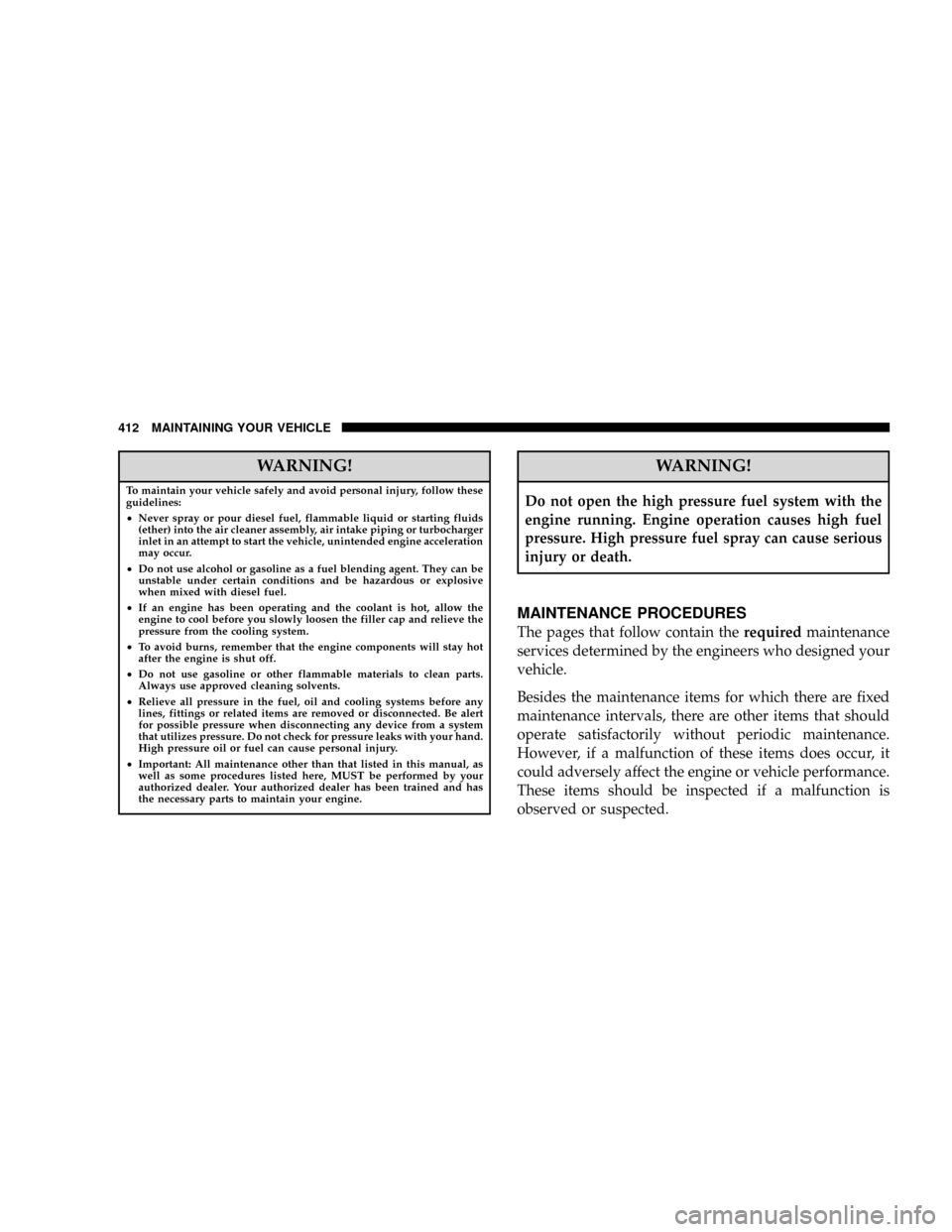
WARNING!
To maintain your vehicle safely and avoid personal injury, follow these
guidelines:
²Never spray or pour diesel fuel, flammable liquid or starting fluids
(ether) into the air cleaner assembly, air intake piping or turbocharger
inlet in an attempt to start the vehicle, unintended engine acceleration
may occur.
²Do not use alcohol or gasoline as a fuel blending agent. They can be
unstable under certain conditions and be hazardous or explosive
when mixed with diesel fuel.
²If an engine has been operating and the coolant is hot, allow the
engine to cool before you slowly loosen the filler cap and relieve the
pressure from the cooling system.
²To avoid burns, remember that the engine components will stay hot
after the engine is shut off.
²Do not use gasoline or other flammable materials to clean parts.
Always use approved cleaning solvents.
²Relieve all pressure in the fuel, oil and cooling systems before any
lines, fittings or related items are removed or disconnected. Be alert
for possible pressure when disconnecting any device from a system
that utilizes pressure. Do not check for pressure leaks with your hand.
High pressure oil or fuel can cause personal injury.
²Important: All maintenance other than that listed in this manual, as
well as some procedures listed here, MUST be performed by your
authorized dealer. Your authorized dealer has been trained and has
the necessary parts to maintain your engine.
WARNING!
Do not open the high pressure fuel system with the
engine running. Engine operation causes high fuel
pressure. High pressure fuel spray can cause serious
injury or death.
MAINTENANCE PROCEDURES
The pages that follow contain therequiredmaintenance
services determined by the engineers who designed your
vehicle.
Besides the maintenance items for which there are fixed
maintenance intervals, there are other items that should
operate satisfactorily without periodic maintenance.
However, if a malfunction of these items does occur, it
could adversely affect the engine or vehicle performance.
These items should be inspected if a malfunction is
observed or suspected.
412 MAINTAINING YOUR VEHICLE
Page 415 of 527
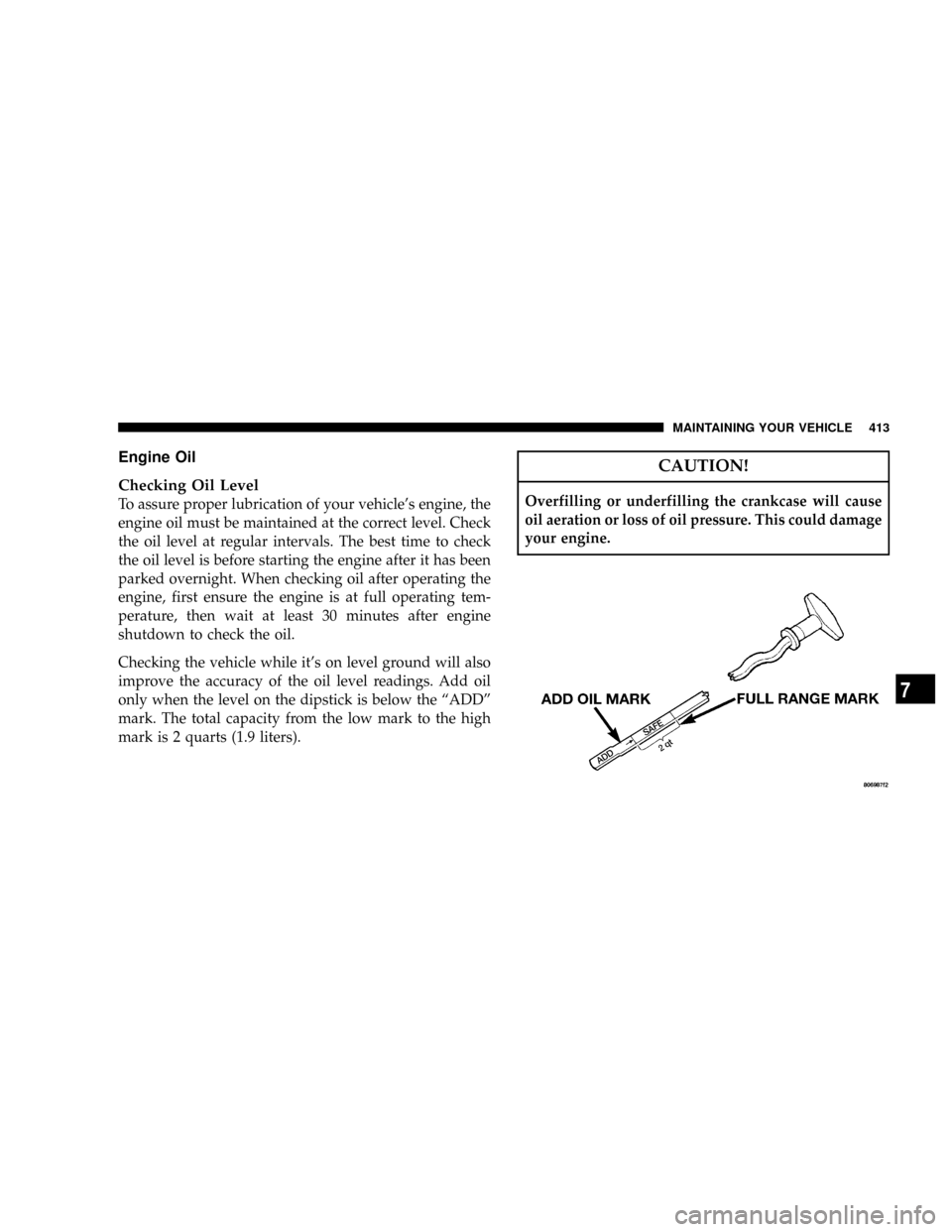
Engine Oil
Checking Oil Level
To assure proper lubrication of your vehicle's engine, the
engine oil must be maintained at the correct level. Check
the oil level at regular intervals. The best time to check
the oil level is before starting the engine after it has been
parked overnight. When checking oil after operating the
engine, first ensure the engine is at full operating tem-
perature, then wait at least 30 minutes after engine
shutdown to check the oil.
Checking the vehicle while it's on level ground will also
improve the accuracy of the oil level readings. Add oil
only when the level on the dipstick is below the ªADDº
mark. The total capacity from the low mark to the high
mark is 2 quarts (1.9 liters).
CAUTION!
Overfilling or underfilling the crankcase will cause
oil aeration or loss of oil pressure. This could damage
your engine.
MAINTAINING YOUR VEHICLE 413
7
Page 438 of 527
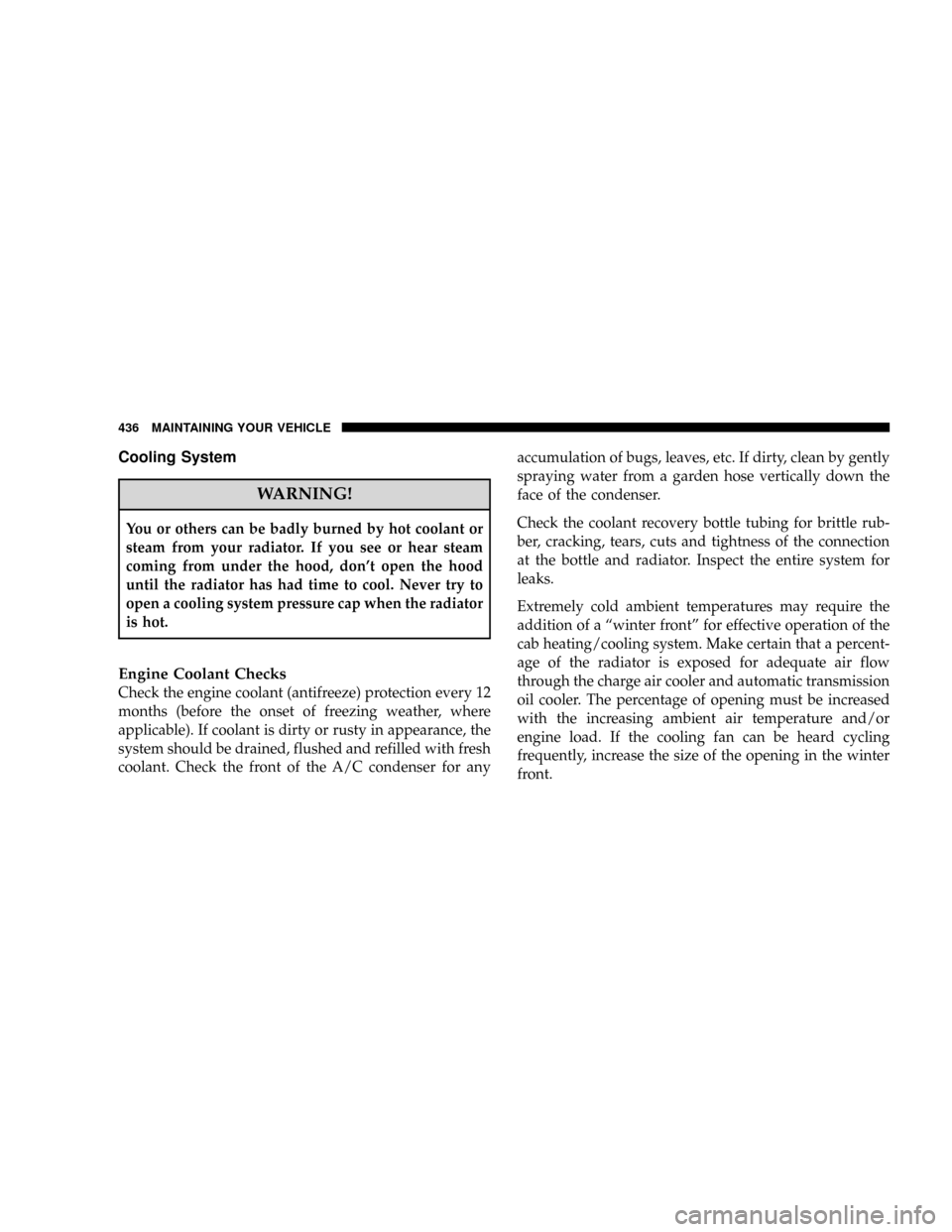
Cooling System
WARNING!
You or others can be badly burned by hot coolant or
steam from your radiator. If you see or hear steam
coming from under the hood, don't open the hood
until the radiator has had time to cool. Never try to
open a cooling system pressure cap when the radiator
is hot.
Engine Coolant Checks
Check the engine coolant (antifreeze) protection every 12
months (before the onset of freezing weather, where
applicable). If coolant is dirty or rusty in appearance, the
system should be drained, flushed and refilled with fresh
coolant. Check the front of the A/C condenser for anyaccumulation of bugs, leaves, etc. If dirty, clean by gently
spraying water from a garden hose vertically down the
face of the condenser.
Check the coolant recovery bottle tubing for brittle rub-
ber, cracking, tears, cuts and tightness of the connection
at the bottle and radiator. Inspect the entire system for
leaks.
Extremely cold ambient temperatures may require the
addition of a ªwinter frontº for effective operation of the
cab heating/cooling system. Make certain that a percent-
age of the radiator is exposed for adequate air flow
through the charge air cooler and automatic transmission
oil cooler. The percentage of opening must be increased
with the increasing ambient air temperature and/or
engine load. If the cooling fan can be heard cycling
frequently, increase the size of the opening in the winter
front.
436 MAINTAINING YOUR VEHICLE
Page 511 of 527
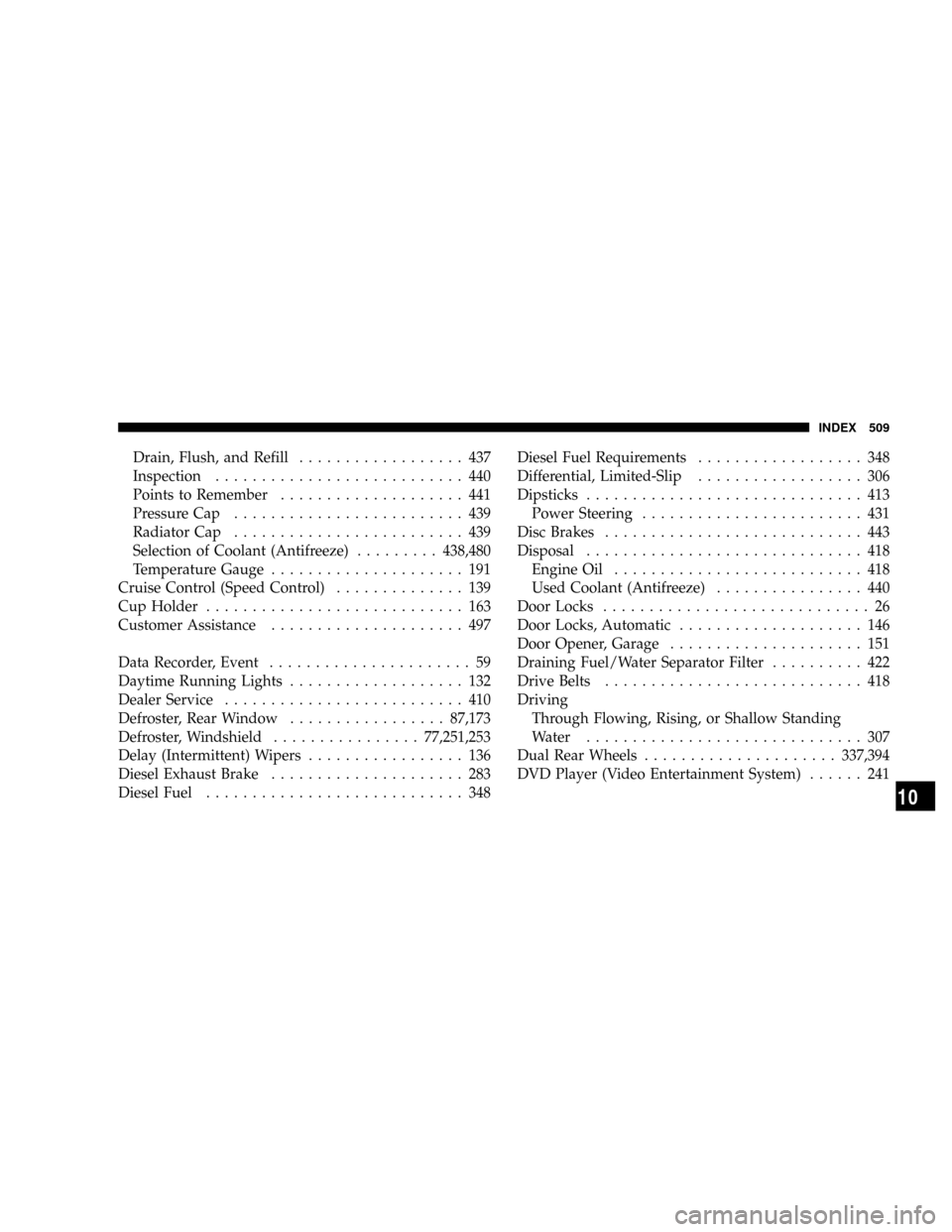
Drain, Flush, and Refill.................. 437
Inspection........................... 440
Points to Remember.................... 441
Pressure Cap......................... 439
Radiator Cap......................... 439
Selection of Coolant (Antifreeze).........438,480
Temperature Gauge..................... 191
Cruise Control (Speed Control).............. 139
Cup Holder............................ 163
Customer Assistance..................... 497
Data Recorder, Event...................... 59
Daytime Running Lights................... 132
Dealer Service.......................... 410
Defroster, Rear Window.................87,173
Defroster, Windshield................77,251,253
Delay (Intermittent) Wipers................. 136
Diesel Exhaust Brake..................... 283
Diesel Fuel............................ 348Diesel Fuel Requirements.................. 348
Differential, Limited-Slip.................. 306
Dipsticks.............................. 413
Power Steering........................ 431
Disc Brakes............................ 443
Disposal.............................. 418
Engine Oil........................... 418
Used Coolant (Antifreeze)................ 440
Door Locks............................. 26
Door Locks, Automatic.................... 146
Door Opener, Garage..................... 151
Draining Fuel/Water Separator Filter.......... 422
Drive Belts............................ 418
Driving
Through Flowing, Rising, or Shallow Standing
Water.............................. 307
Dual Rear Wheels.....................337,394
DVD Player (Video Entertainment System)...... 241
INDEX 509
10